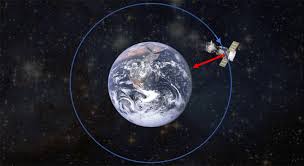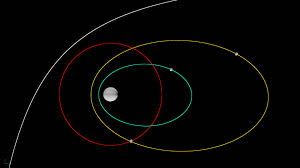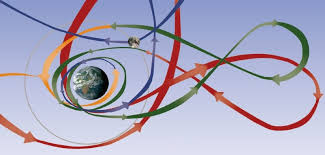Orbital mechanics, also known as astrodynamics, is the branch of physics and engineering that studies the motion of objects in space. It is the foundation for understanding how spacecraft travel through space, how satellites remain in orbit, and how celestial bodies interact with one another. This field combines principles from Newtonian mechanics, gravitational theory, and advanced mathematical techniques to analyze and predict orbital trajectories. In this article, we explore the fundamental concepts of orbital mechanics, its applications, and the latest developments in the field.
Contents
The Basics of Orbital Mechanics

Orbital mechanics revolves around the laws of motion and gravity established by Sir Isaac Newton and refined by later scientists. At its core, it explains how objects move in the gravitational fields of celestial bodies.
The first law of orbital mechanics, often attributed to Johannes Kepler, states that celestial bodies follow elliptical orbits with the center of mass of the system, typically a planet or a star, at one of the ellipse’s foci. This elliptical nature is central to understanding orbits, as it explains why objects in space do not travel in perfect circles.
Newton’s law of universal gravitation quantifies the gravitational force acting between two objects. This force depends on the masses of the objects and the distance between them. Combined with Newton’s second law of motion, these principles allow scientists to calculate the velocity and trajectory required for an object to enter, maintain, or leave an orbit.
Types of Orbits and Their Characteristics
Understanding the different types of orbits is crucial for applications ranging from satellite communications to interplanetary exploration. Some of the key orbital classifications include:
- Low Earth Orbit (LEO): This orbit lies between 160 km and 2,000 km above Earth’s surface. LEO is commonly used for Earth observation satellites, the International Space Station, and some communication satellites. Objects in this orbit experience significant atmospheric drag, requiring periodic adjustments to maintain their trajectory.
- Geostationary Orbit (GEO): Positioned approximately 35,786 km above the equator, satellites in GEO appear stationary relative to the Earth’s surface. This orbit is ideal for weather monitoring, telecommunications, and broadcasting.
- Polar Orbit: Satellites in polar orbits travel over the Earth’s poles, allowing them to observe the entire planet as the Earth rotates. These orbits are widely used for environmental monitoring and reconnaissance.
- Transfer Orbits: Transfer orbits, such as the Hohmann transfer orbit, are used to move spacecraft between two different orbits. These paths are carefully calculated to minimize fuel consumption while ensuring the spacecraft reaches its destination.
Orbital Maneuvers and Navigation

Orbital maneuvers are essential for adjusting a spacecraft’s trajectory or transferring it to a new orbit. These maneuvers rely on precise burns of onboard propulsion systems to change the velocity of the spacecraft, a concept known as delta-v.
Key maneuvers in orbital mechanics include:
- Launch to Orbit: The first step for any space mission is achieving the velocity required to enter orbit. This involves overcoming Earth’s gravity and atmospheric drag during launch.
- Inclination Change: Adjusting the angle of an orbit relative to Earth’s equator requires significant energy and is often avoided unless absolutely necessary.
- Interplanetary Transfers: For missions to other planets, spacecraft use gravitational assists and transfer orbits to minimize fuel use while maximizing velocity. This technique has been successfully used in missions like Voyager and Cassini.
Applications of Orbital Mechanics
Orbital mechanics plays a pivotal role in modern society, enabling wdbos numerous technologies and scientific endeavors. Some of the critical applications include:
- Satellite Deployment: Satellites for communication, navigation, weather monitoring, and scientific observation rely on precise orbital calculations to function effectively.
- Space Exploration: Missions to the Moon, Mars, and beyond depend on orbital mechanics to chart courses, optimize fuel usage, and ensure spacecraft arrive at their destinations.
- Planetary Science: Understanding the orbits of celestial bodies helps astronomers predict eclipses, study planetary formation, and explore asteroid trajectories.
- Space Tourism and Commercial Spaceflight: As private companies venture into space tourism, orbital mechanics ensures safe and efficient travel for passengers.
Challenges in Orbital Mechanics

Despite its established principles, orbital mechanics faces several challenges, especially in the context of modern space exploration and satellite operations.
- Orbital Debris: The increasing amount of debris in Earth’s orbit poses a threat to satellites and space missions. Predicting and avoiding collisions requires advanced models and tracking systems.
- Fuel Efficiency: Spacecraft propulsion systems must balance limited fuel resources with the need for precise orbital maneuvers. This constraint drives innovation in propulsion technologies, such as ion engines and solar sails.
- Complex Gravity Fields: Navigating near large celestial bodies with irregular gravitational fields, such as asteroids, requires detailed modeling and real-time adjustments.
Recent Advances in Orbital Mechanics
The field of orbital mechanics continues to evolve with advancements in technology and computational methods. Recent breakthroughs include:
- Artificial Intelligence and Machine Learning: AI is increasingly used to predict orbital trajectories, optimize maneuvers, and manage satellite constellations.
- CubeSats and Small Satellites: The rise of small, low-cost satellites has revolutionized access to space. Orbital mechanics ensures these satellites can be deployed effectively in LEO and beyond.
- Lunar and Martian Missions: Renewed interest in lunar exploration and plans for human missions to Mars have spurred advancements in trajectory design and interplanetary navigation.
- Space Traffic Management: With the proliferation of satellites, managing space traffic has become a priority. Orbital mechanics plays a central role in avoiding collisions and maintaining safe operations in crowded orbits.
The Future of Orbital Mechanics
As humanity ventures further into space, the importance of orbital mechanics will only grow. From building sustainable lunar habitats to exploring distant exoplanets, the principles of orbital motion will underpin every step of our journey.
Advancements in propulsion systems, computational power, and collaborative international efforts promise to push the boundaries of what is possible in space exploration. At the same time, the need for responsible orbital management and debris mitigation will ensure that the space around Earth remains accessible for generations to come.
In conclusion, orbital mechanics is a dynamic and essential field that bridges the gap between theoretical physics and practical space exploration. Its principles guide satellites, spacecraft, and humanity’s dreams of reaching the stars. As we continue to innovate and expand our presence in space, the lessons of orbital mechanics will remain at the heart of our achievements.



